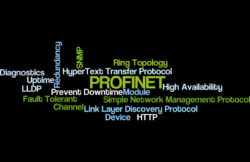How much does downtime cost you in your plant? An automotive plant’s downtime could cost $10,000 per hour. Your mileage may vary, but there definitely is a cost for downtime at your plant. And you can’t be everywhere all the time to know whether your process is running as it should. You need an extra set of eyes and ears constantly monitoring your system. That’s where PROFINET comes in. PROFINET helps prevent downtime and save money through two mechanisms: diagnostics and fault tolerance.
PROFINET can diagnose your system by combining the successful concepts of PROFIBUS with network  diagnostics via standard Ethernet protocols like HTTP. Like PROFIBUS, PROFINET alarms if a device fails, a module in a device fails (or is removed), and if an individual channel on a module goes on the fritz. For example, if a digital output is logically “on,” but no current is flowing, PROFINET can report a wire break. If a 0-10Vdc input registers 11Vdc, PROFINET can report it.
diagnostics via standard Ethernet protocols like HTTP. Like PROFIBUS, PROFINET alarms if a device fails, a module in a device fails (or is removed), and if an individual channel on a module goes on the fritz. For example, if a digital output is logically “on,” but no current is flowing, PROFINET can report a wire break. If a 0-10Vdc input registers 11Vdc, PROFINET can report it.
PROFINET network diagnostics rely on Ethernet protocols familiar to the IT staff: HTTP, SNMP, and LLDP. Everyone uses HTTP (HyperText Transfer Protocol). In fact, you’re using it now; it’s the protocol that lets a web browser view a web page. PLCs and other controllers often have a web server built-in so you can configure them and access information. Similarly, managed Ethernet switches, drives, wireless access points, and other devices provide a web interface as well.
SNMP (Simple Network Management Protocol) provides information about Ethernet networks by accessing data in Ethernet switches (standalone switches or those built into PROFINET devices). Is this port sending and receiving data? Are there lots of retries on that port? SNMP can tell you, so you can act before production is impacted or quickly recover if the line does go down.
LLDP (Link Layer Discovery Protocol) checks on network neighbors. It exchanges messages with the device on the other end of the wire and stores that data. That data can be accessed using standard IT tools (and special-purpose industrial tools) to determine the network topology. It also can alarm if a link goes down. LLDP is required in PROFINET devices.
Now let’s look at fault tolerance. One example of fault tolerance is redundancy. It prevents downtime by keeping a single failure from shutting down production. PROFINET supports both network ring and dual ring topology. With ring topology, a failure in one part of the ring is immediately corrected by routing PROFINET messages “the other way around the ring.” In addition, PROFINET supports redundant controllers, also called “hot standby.” Two controllers communicate so if one fails, the other can seamlessly take over. Finally, PROFINET supports redundant devices. If one I/O block fails, its hot standby I/O block takes over.
The more expensive downtime is at your plant, the more you need PROFINET to prevent and shorten downtime. It’s like having someone constantly monitoring your system—but without having to add them to your payroll.
[Cross posted at GE Automation blog: http://www.geautomation.com/blog/let-profinet-monitor-your-system-increase-uptime]
–Carl Henning
